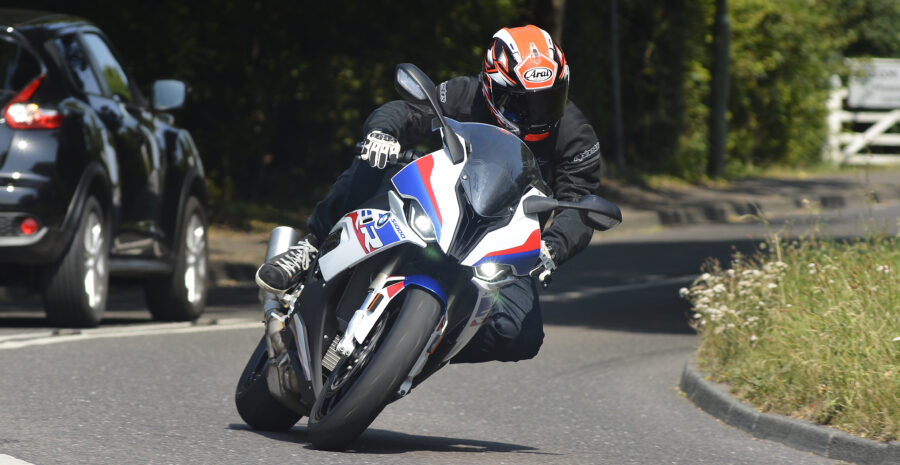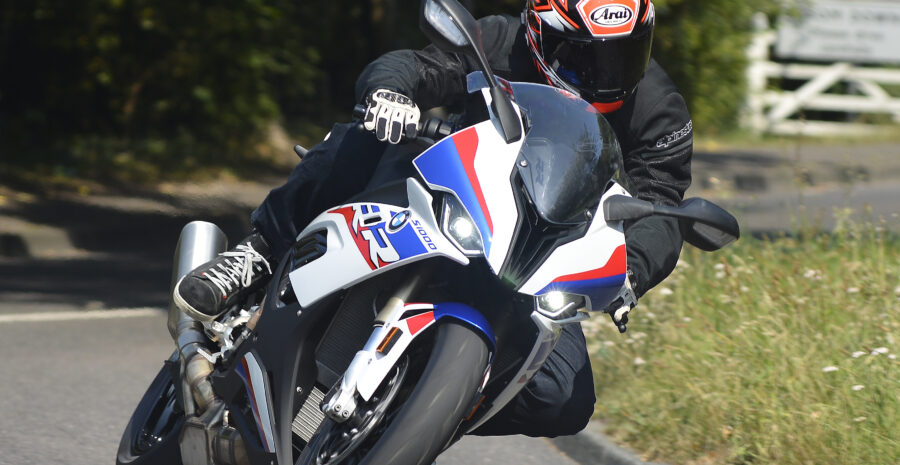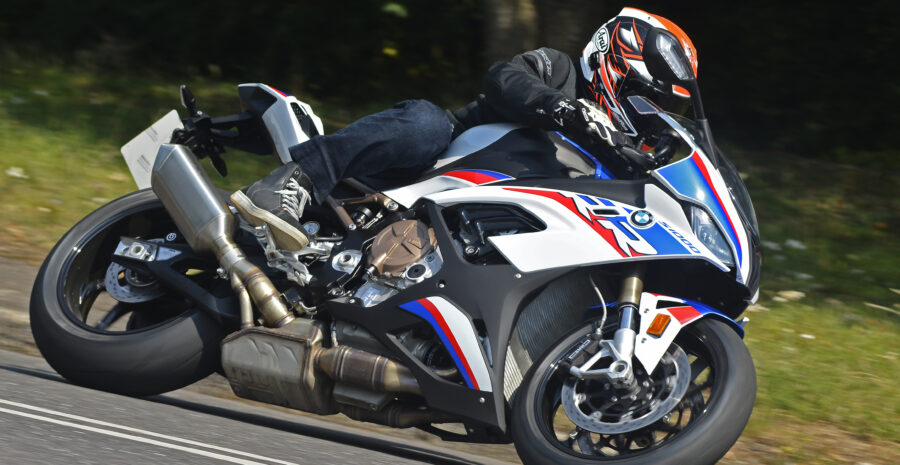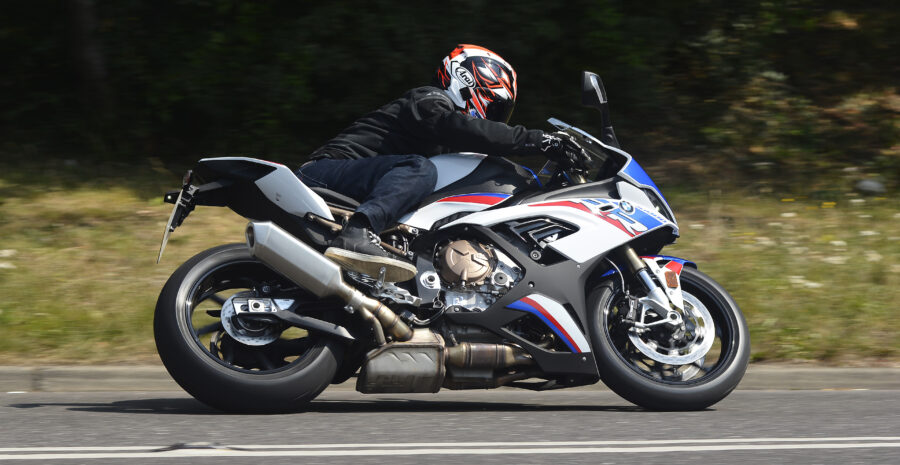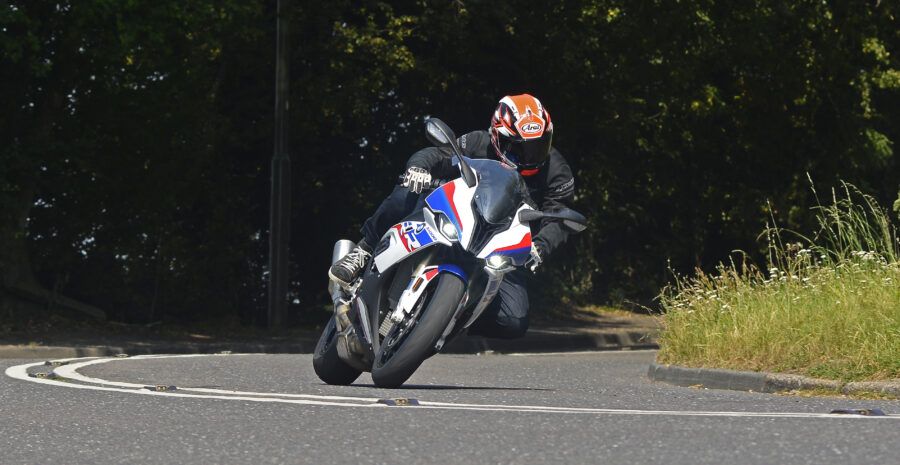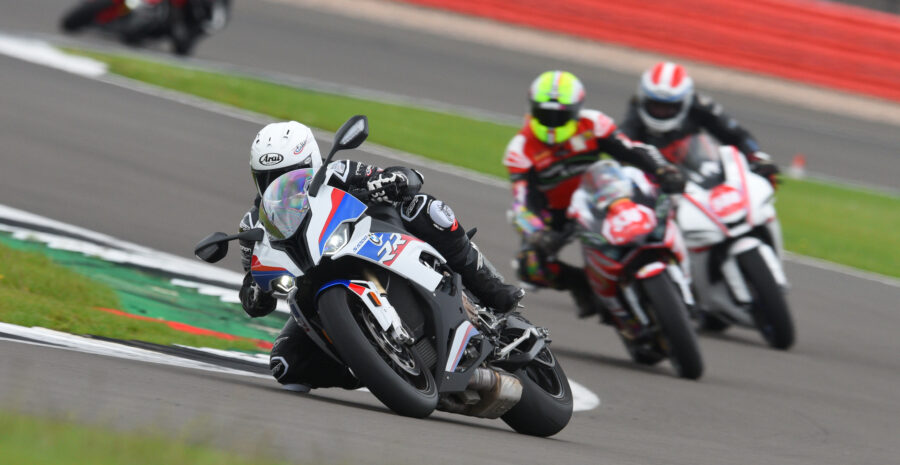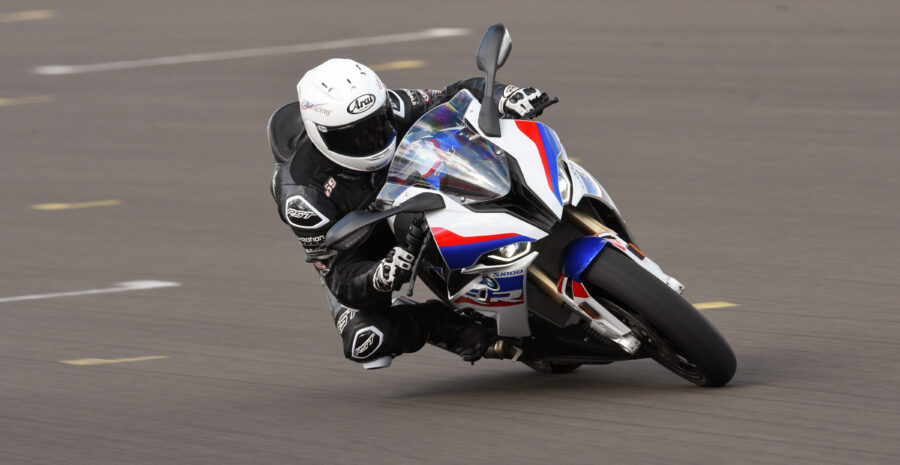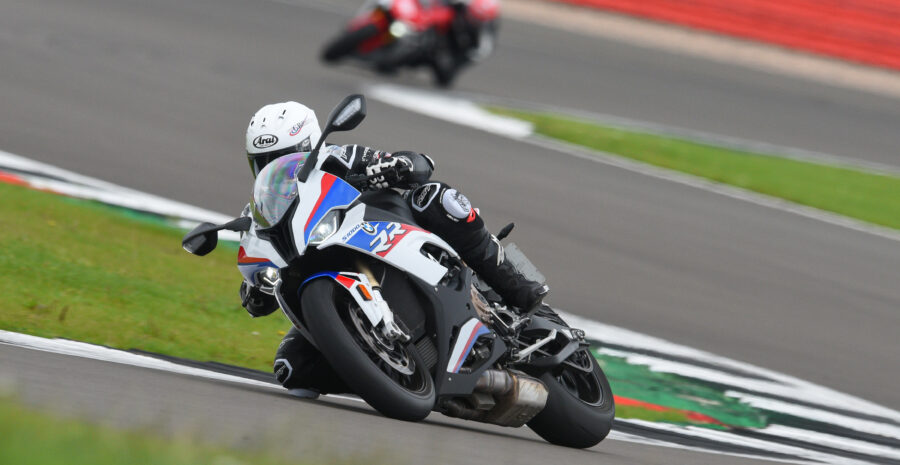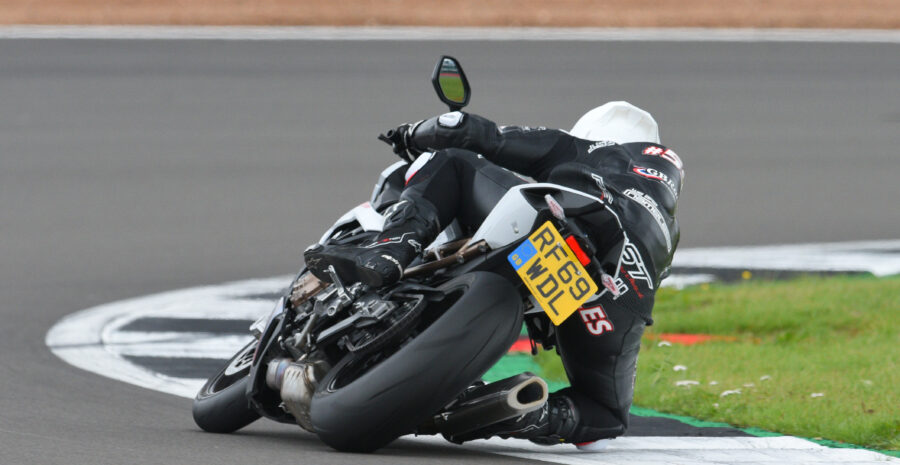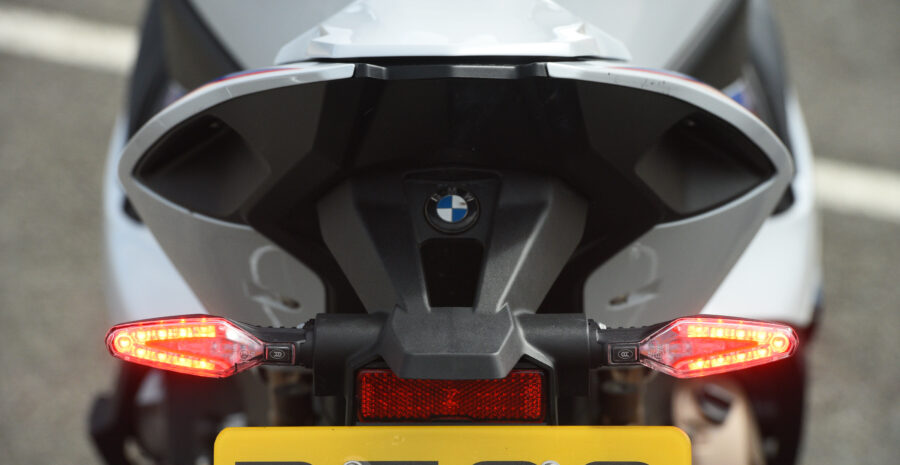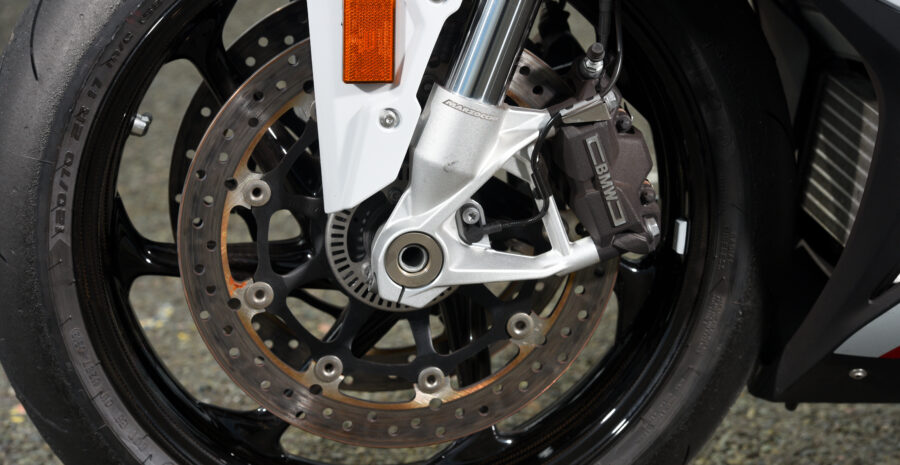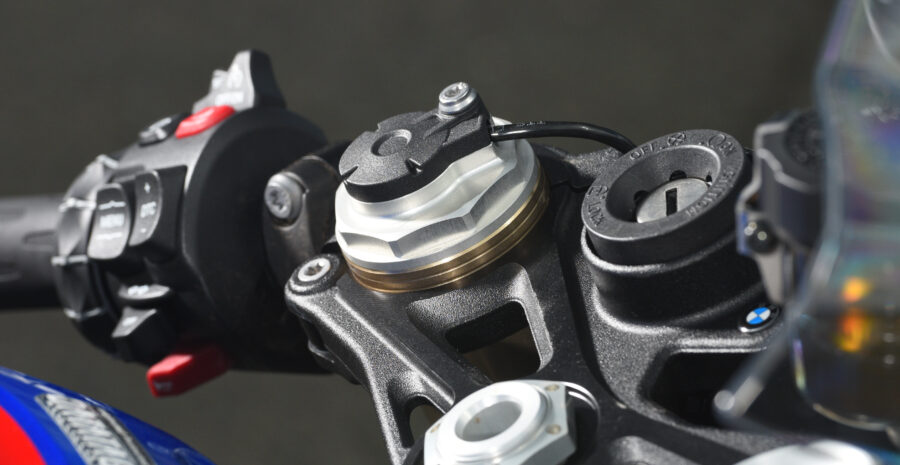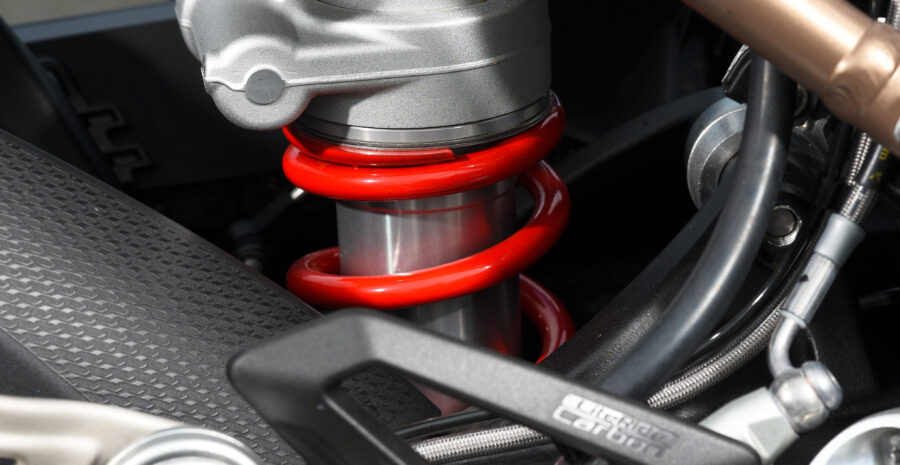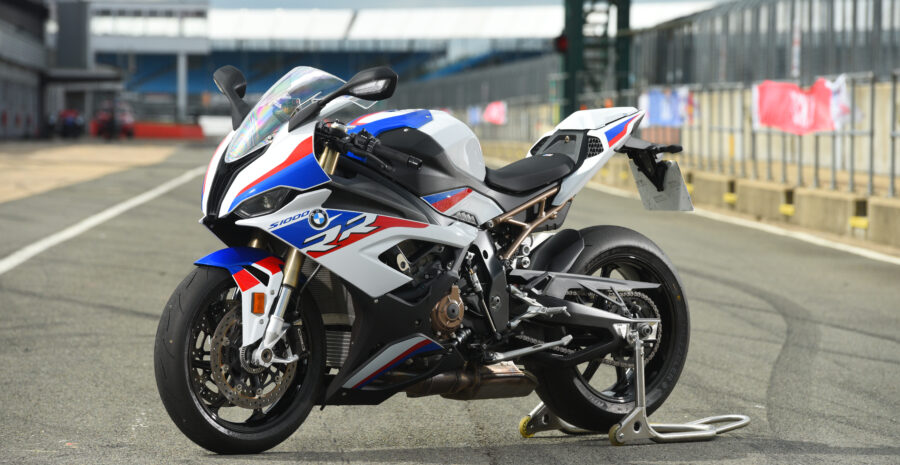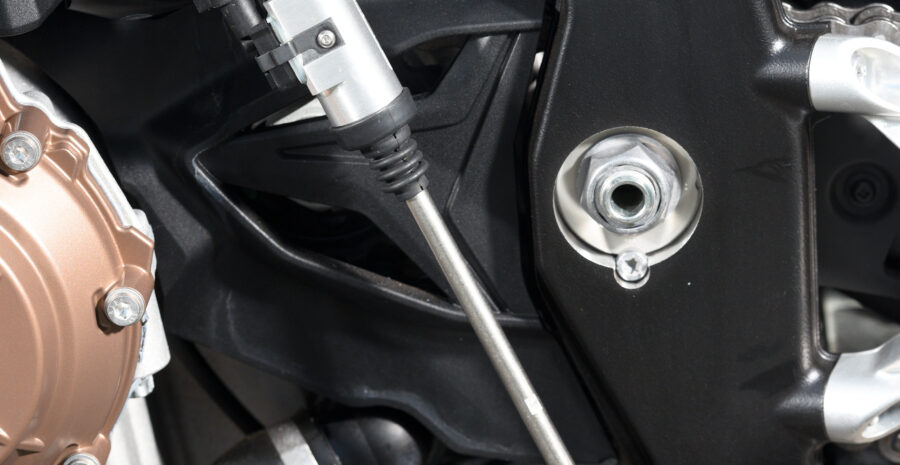We went to the S1000RR launch last year at Estoril — but it was, frankly, a bit of a washout. Production problems meant the bikes didn’t make it to the UK in big numbers till late on last year — and then we all know what happened this year…
So as the coronavirus lockdown lifted, and the weather got tropical, we borrowed BMW’s S1000RR for a couple of weeks here in the UK.
I spent a week on it on the roads for a sensible view on what it’s like in daily life while Rob took it to its natural environment for a blast round Silverstone’s National circuit, the layout used for British Superbikes this year.
Road Test
About a week after I had the BMW S1000RR out on test, a story appeared in the press which grabbed my attention. A South African conservationist, West Mathewson had rescued a pair of lion cubs and brought them up to adults. Adult lions, who attacked and killed him last month. Boooh.
It’s not such a rare story — the mad antics of the redneck protagonists in the Netflix series Tiger King shows that there are plenty of folk, especially in the US, who take on big cats as babies, only to be, er, overtaken by them later on.
Now, I’m not saying that buying a modern superbike and riding it on the road is exactly like keeping a lion cub as a pet. But there are parallels. It’s an undeniably cool thing to do — walking down your high street with a white lioness on a lead knocks the crap out of a pit-bull/staffie cross.
And you have to think that no-one’s going to be breaking into your house. Similarly, cruising to the shops on a 20-plate BMW S1000RR is better than doing it on a ratty K100 (though it’ll have the opposite effect on thieves…)
The danger is part of the coolness of course. As Mr Mathewson’s case shows, even a lifetime looking after wild animals is no guarantee that they won’t turn on you. And no matter how long you’ve been riding, 210bhp in a 200kg motorbike is almost other-worldly in terms of potency. You need to be very, very, VERY careful with it.
Finally, neither a giant felid apex predator, nor a full-bore superbike is very practical on a day-to-day basis.
It’s hard enough getting a neighbour to come and water the plants when you go away on hols — imagine trying to find someone to throw half a goat over the fence twice a day. And a £20k M-sport S1000RR isn’t the best option for a daily commute up town, parked on the street, even if the weather is nice and you have a big lock.
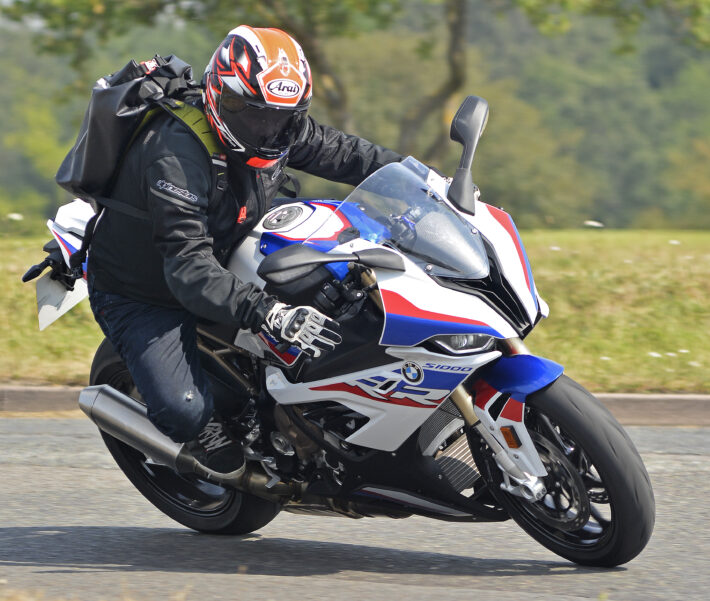
So — impractical and risky to both life and licence.
I must have had a rubbish time on the S1000RR, right?
Of course not.
It’s an incredible piece of moto-engineering art, and once you adapt, it’s actually great to live with. The rider aids are ultra-comprehensive and really do work, even away from the circuit.
I had a very narrow squeak (literally!) at one point: I was following a Sprinter van down the fast lane of a dual carriageway ‘at speed’.
There was queuing traffic in that lane up ahead, which I couldn’t see, until the Sprinter swerved into the empty slow lane, leaving me suddenly facing the back of a Luton van doing 5mph… Instinctive self-preservation hammered on the front brake, and flung the S-thou hard left.
You don’t hear a superbike’s front tyre squeal often, but there was a definite chirrup from the momentarily-tortured front Metzeler, and I’m convinced that BMW’s cornering ABS Pro saved me from sliding unceremoniously into the back of that traffic queue.
You can’t escape the relentless temptation for bad speed of course — though the cruise control can help here. Set it to 76mph when you’re killing miles on a busy motorway or dual carriageway, and you have a degree of safety.
While we’re on the subject of convenient luxury, our M-Sport bike came with heated grips (yum), and the massive colour LCD dash is now standard on big BMWs.
Add in the excellent quickshifter, tyre pressure monitor, extensive trip computer, Bluetooth integration with media, phone and navigation functions, and you have a very useful infrastructure for ‘normal’ riding, should you need to do it.
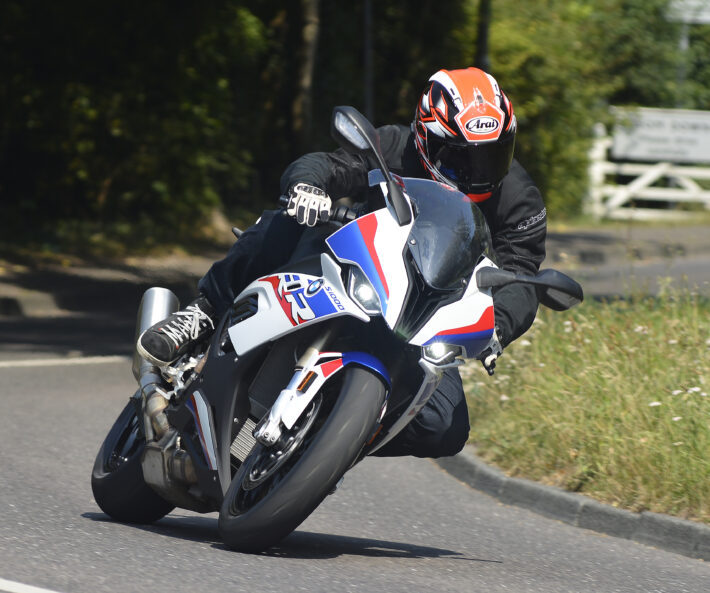
If you’re younger or more limber than me, and can fit into the (not too extreme) riding position properly, then it’ll be comfy for a few hundred miles for sure. Add in the bespoke soft luggage (tail pack, tank bag, sport panniers) and you’ll be sorted for a ‘Nick Sanders’-style assault on proper long journeys…
The outright performance is of course stunning. Rob’s track test will give you a more in-depth view of chassis and engine in their natural environment, but it’s incredible on the road. Get out onto a suitable piece of A-road, and you can sample the highest levels of exhilaration two wheels can offer.
The latest engine with its ShiftCam top-end has crazy peaks, but is super-tractable too. It’s still not quite as strong as the daft 1100 superbikes from Ducati and Aprilia, but is pretty close (why B-M doesn’t also do a cheeky big-bore S1100RR for the road is beyond me).
The Hayes brake calipers and Sachs/Marzocchi electronic suspension isn’t as fancy as the Brembo/Öhlins MotoGP-alike kit on offer elsewhere, but they do let BMW sell this bike a little cheaper than you might expect, and work just as well on the road.
At the end of the day though, much of the S1000RR’s potential is a little wasted on the road. And since BMW (and most other firms) have put plenty of effort into their non-superbikes, you can get almost (*almost*) as much performance from a comfy armchair-type machine like the S1000 XR, or even (whisper it) the latest R1250 GS.
Both have a few notches taken off the ultimate performance, but are close enough 90 per cent of the time on the road (especially the XR).
But none of them have the parked-up-at-Rykas appeal of a 207bhp carbon-wheeled, angry-faced superbike. If you simply must have a roaring white lion on the end of your lead, rather than a purring, house-trained tabby cat, then the 2020 S1000RR does the job like nothing else out there…
Track Test
I’ve never really been one for reading the manual. I pull the tyre warmers off the fresh Metzeler Racetec K3 tyres, marvel at the gorgeousness of the carbon wheels, take the German supermodel off its stands and… wonder why the brakes are binding…
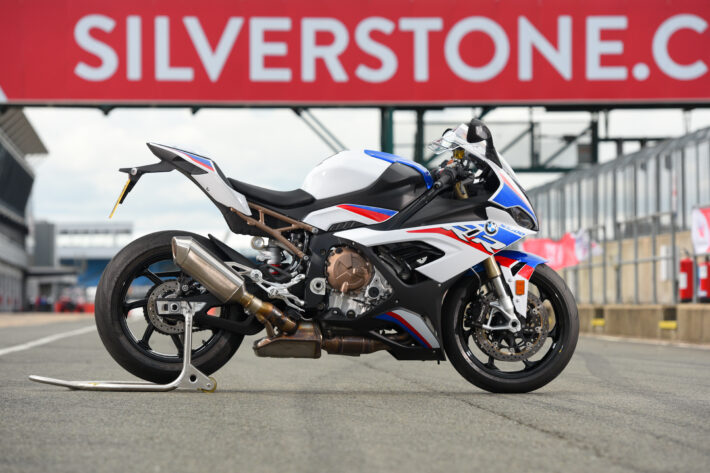
Of course, they’re not, though less obviously it appears the S1000RR has a handbrake. Well alright, not a handbrake but a hill-start assist system that has me pondering if it’s such a good idea for anyone who struggles with this fairly basic skill to be swinging a leg over a 210bhp superbike in the first place. I’ve been up since 4:30am, bear with me…
Out of pitlane, a huge warning message flashes up on the dash instructing me to stop immediately because my tyre pressures are ‘out of range’ having set them on the warmers to moderately sensible track pressures of 35PSI in the front and 28 in the rear.
It takes me a while to work out how to get rid of it but eventually it disappears.
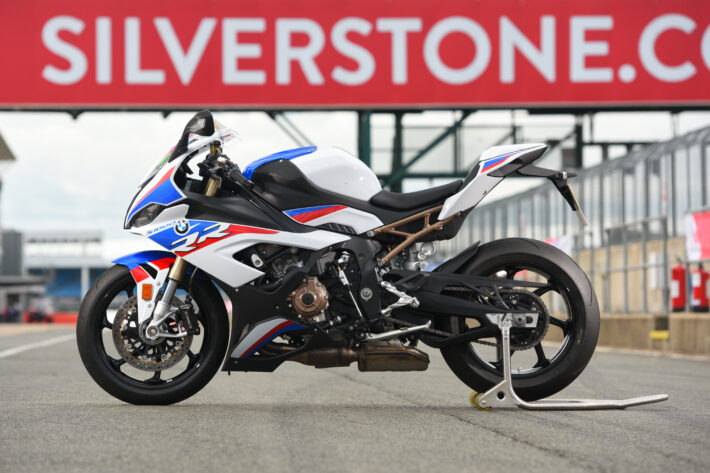
Not the most auspicious of starts, granted, but it does serve to highlight the mass of technology packed into this incredible machine as tightly as the dictionary-thick handbook is squeezed under the tail-cover. I make a pledge to start reading manuals from now on.
I was first impressed by the S1000RR from the seat of a CBR1000RR when I had a go at Superstock in 2010. Back then they may as well have had their own overtaking lane on pretty much every straight piece of tarmac.
I’ve since seen the BMW improve with every update, each niggle addressed, every bit of feedback considered and used in the S1000RR’s evolution.
It’s always been a strong package with plenty of success in Superstock — to my mind the most accurate measure of how good a bike is from the crate.
It’s been a winner from the outset. This completely new model, however, takes things to another level.
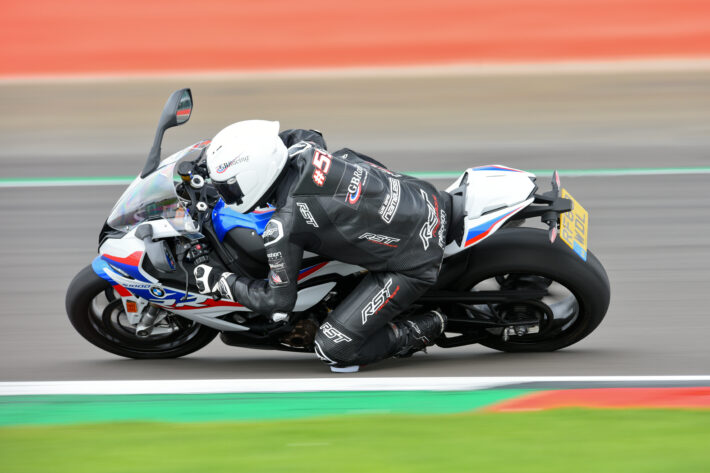
The scope for push-button personalisation is immense, and for those of us born long before smartphones and tablets existed, possibly a little overwhelming.
The system is perhaps not quite as user-friendly as Yamaha’s R1 (my benchmark, I regularly ride these instructing on Silverstone track days) but with a little practice flicking through the options becomes more and more intuitive.
I tried the various Rain, Road, Dynamic and Race modes on the road and felt that they were pretty much ideal for wet weather, going to work, going a bit daft and quite possibly going to hospital.
Changes to power delivery and suspension were really quite pronounced and, to my mind, well suited to their intended task. Tired riders make dangerous riders.
So being able to detune a machine that at full power requires 100% focus on the road is probably not such a bad thing.
Al mentioned the cruise control before in his road test, and that really is one of the best safety aids on this bike, especially for those who like taking liberties but would rather not sacrifice their own.
Sorry, I’m going off at tangents, so I’ll refocus and get back to that first, uneducated, track session. The M-Sport version has three customisable ‘Race Pro’ modes in addition to the more road-oriented modes I’ve just mentioned.
Here you can tweak away to your heart’s content, with incremental changes to the throttle response, engine braking, traction control and wheelie control allowing for even the fussiest of fiddlers to find a setting they like. But then I still haven’t read the manual.
‘Race Pro 1’ appears to be set up with minimal computer interference so it seems as good a starting point as any. I don’t realise the traction control is turned all the way off until I’m fired out of the seat quite a long way out of Woodcote on the run on to the start/finish straight.
Other slides are more progressive with plenty of time to enjoy being out of line on the long, off-camber exit of Copse and only what I’d really call ‘squiggles’ elsewhere.
Throttle connection is a real strong point of the S1000RR, the rear tyre really talks to you. Sometimes it screams. Quite often it laughs…
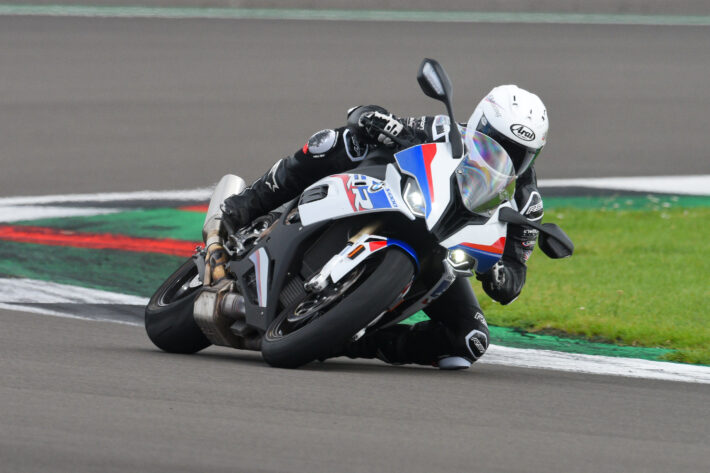
About three laps in I decide I want a less aggressive throttle response when tapping back on mid corner from fully closed, a bit more engine braking to settle me into the turn and, after a few, slightly less fun, slides, some traction control might be nice, too.
Hard to think that a decade ago only a factory racer could ask for such changes. Even then he’d need a bloke with a degree in physics and a laptop to come and sort it out.
Unless you’ve no imagination or haven’t read a sports bike test in the last ten years then you probably already have a fair idea what 210bhp feels like. It’s a lot of power.
An immense amount. Almost unmanageable. But with the ShiftCam technology, BMW has created something just that little bit different to other four-cylinder bikes (with the exception of the crossplane-cranked Yamaha R1 with its V4-aping firing order) by having the ability to alter the camshaft profile once the motor gets above 9,000rpm.
What this means is you can have a softer cam profile for lower rpm and a more aggressive profile when the bike is upright and there’s no longer such a thing as too much power.
I won’t dive too deep into the detail here (see tech boxes below for more), but it’s a really clever yet simple system that brings even more flexibility to the motor. Google ‘Peter Hickman explains ShiftCam’ and you’ll get the basics explained really well by the TT lap record holder.
The motor spins up very quickly and has quite a lot of over-rev. This catches me out a few times in the first session. Usually the point at which you shift gears is totally intuitive with a build of torque that feel natural.
It’s a little different with the BMW and while I’m fine on the straights, occasionally through the longer right-hand corners, where I’m looking up the track and not at the shift lights on the dash, I definitely need to shift earlier.
It’s a weird one to explain but the bike doesn’t hit its peak and then bounce against a limiter; the power tails off for some time first. An observation, not a criticism, and by session three it feels a lot more instinctive.
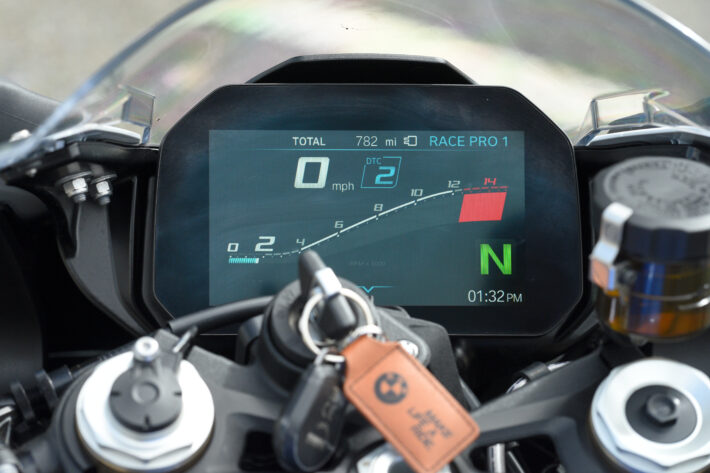
Having become a little more familiar with the bike and its impressive gadgetry (Much of my lunch hour is spent reading the manual…) everything becomes more fluid.
I’ve got my head round where I need to shift and which gear suits which corner. The gear shift itself is beyond impressive.
Slick doesn’t even come close, up and down the gearbox, both the quick-shifter and the blipper work fantastically well and the lever feels more like a switch than a mechanical shifter. There were no missed gears all day, which is something I can be quite good at. Pretty sure there’s still a bit of my Honda’s gearbox in the Stowe gravel trap from 2010…
Handling was never exactly an S1000RR weak point, and the new bike is an absolute razor. It’s fast steering and holds a line really well, the more road-biased Racetec K3 tyres and my bravery seemingly the two biggest limiting factors to high corner speeds.
Race-spec Supercorsas or, better still, slicks, would bring the best from the excellent chassis.
The Marzocchi active suspension came as something of a surprise to most people when the bike was unveiled but it works well with decent damping and a good feeling of front to rear balance with controlled weight transfer coming off the brakes and onto the throttle.
The same solid feeling to the front end that riders of the outgoing model enjoyed with the Sachs forks remains too. The rear shock also works well, with very little pumping, even being fairly aggressive on corner exits.
If we were surprised at BMW’s choice of suspension supplier, then the arrival of Hayes as the brake supplier was a real curveball.
I’d had Hayes brakes on an old mountain bike years ago but had no idea until last year that they had made big inroads with high-performance motorcycle brakes, the Milwaukee firm developing its calipers in MotoAmerica (previously AMA).
There’s not much to say about the brakes really, other than the three-brand mix of Nissin master cylinder, Hayes calipers and Brembo discs works very well.
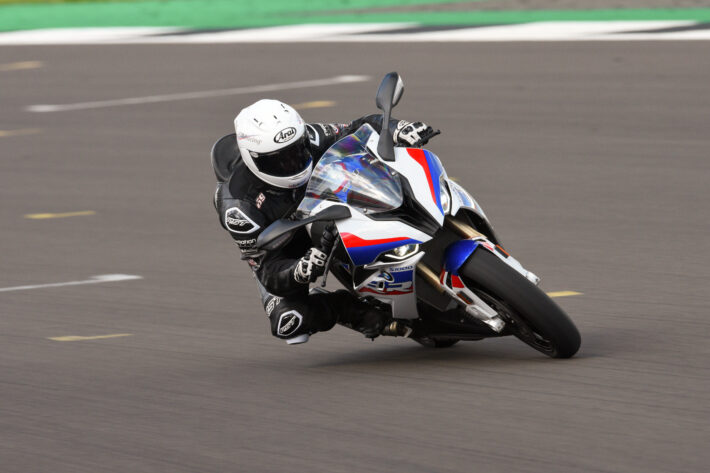
Plenty of feel at the lever, loads of stopping power with a highly adjustable ABS system to suit the conditions. And certainly in the same league as the OE Brembo calipers you might find on other litre-class sports bikes.
It’s hard to not be impressed by the BMW. It’s been built to win races and while it’s struggling a little in the Superbike classes, it’s been running right at the front in the Superstock class and won a couple of TT races last year in the hands of Peter Hickman (the Smiths Racing hat-trick lost only to an overheating superbike motor, a problem that has since been remedied with a new water pump design).
As a road bike it works too, if sports bikes on the road are your thing. I totally get why someone might want to ride an S1000RR on the road, but for me it’s a bit of a waste.
Knowing you’re only using a modicum of the bike’s ability and only a fraction if its power should force you to take this bike where it belongs. Where it insisted I take it after an hour on the road. To a racetrack. A really big, fast one. In fact, I’m pretty sure it says as much in the manual…
Thanks to BMW Motorrad UK for the loan of the bike and to Silverstone for some quality track time.
TECH BOXES
ENGINE
Lots of changes here: it’s pretty much an all-new engine. It’s lost 4kg in weight and is 12mm narrower – but the major change is the ShiftCam variable intake valve system. This sounds complex, but when you see it in front of you (they have a stripped down head here) it’s actually fairly simple. If you’ve seen how a motorbike gearbox works, that helps – the same idea that slides selector forks from side to side in the transmission moves cam shafts here.
Sliding outer camshafts move axially along a splined inner drive shaft, and bring one of two cam profiles into play, one for low-down performance, one for peak power. The cams are moved by a clever solenoid pin system, located in spiral grooves on the sliding shaft.
When the ECU pushes one pin out, it engages in the groove, and as the shaft turns, slides the cam profile along. To change back, it pulls out that pin, and pushes another down, to engage grooves in the other direction, moving the shaft back again.
Having the choice of two cam profiles depending on engine speed gives a big boost in low-down and midrange power, better fuel economy and reduced emissions. Is it as strong as an 1100cc engine? Not quite – but it’s getting there.
The 16 valves are all titanium, and the larger intake valves are ten percent lighter thanks to hollow shafts. Added to the new teeny-tiny 8-gramme DLC-coated finger tappets, this means a sky-high new rev limit – up from 14,200 revs to 14,600rpm.
FRAME
All-new cast aluminium design, which uses the engine more as a stressed member, which saves weight (down 1.3kg) and has carefully designed ‘tuned’ flex, for improved rigidity and handling. The new swingarm is a factory-looking underslung design, and longer than before at a devilish 606.6mm. If you spring for the £19k M-Package bike, you also get an adjustable swingarm pivot, and ride height adjustment, which will help you get the optimum setup for your regular Sunday blast to the seaside, no doubt.
SUSPENSION
The base bike has perfectly decent-looking no-brand suspension, while the M-Package machine has BMW’s DDC semi-active electronic kit (also an option on a base bike if you spec it while buying). The rear shock is now mounted in a ‘floating’ layout, meaning it’s not attached to the main frame, but is held within the swingarm and linkage).The fork is a new 45mm USD design.
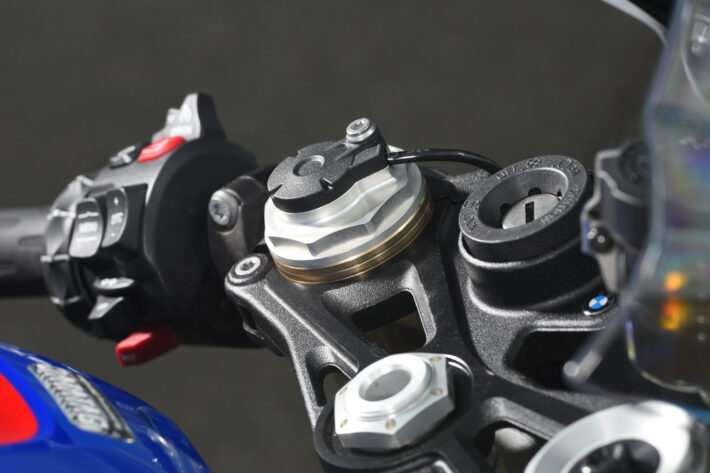
On the DDC electronic setup, the ECU-controlled semi-active damping is linked to the overall rider modes. The shock electronics are more advanced than before, and can now be tweaked by aftermarket suspension specialists. The internal shim stacks can be modified to work alongside the electronic systems – before, you couldn’t do that.
BRAKES
The old Brembo front brake system has been swapped for a new setup by Hayes – an American firm better known for its mountain bike and Harley brakes (BMW also did this on the R1250 range for 2019). They wear BMW branding, and look good, with a solid, four-piston radial-mount design, and a Nissin master cylinder.
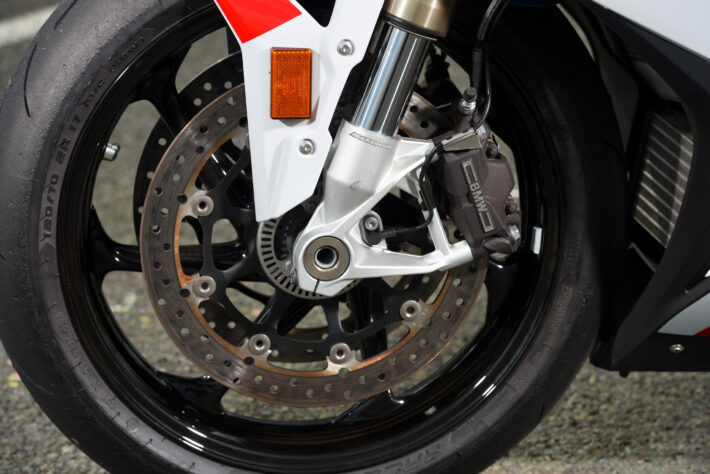
WHEELS/TYRES
On the base model S1000RR, you get cast alloy rims which weigh 1.6kg less in total than the old bike’s wheels. The M Package swaps these for even lighter M-Sport carbon wheels, similar to those on the HP4 Race.
ELECTRONICS
At the heart of a very advanced setup is a six-axis IMU brain, that measures what the bike is doing hundreds of times a second, It’s accessed via BMW’s twistgrip controller, plus a huge colour TFT LCD dash. There’s cornering ABS, plus a new separate wheelie and traction control system. So you can have separate limits for wheelies and traction, keeping the safety net of TC when leant over in a bend, while still being able to do wheelies while upright. We also get launch control, pitlane limiter, cruise control, up/down blipping quickshifter, wheelie assistant, and hill-start control on the ABS (a harder tug on the front lever locks the brake on to stop you running backwards down a hill).
The ‘M’ and ‘Sport’ packages add ‘Pro’ riding modes, that adds three additional ‘Race Pro’ customisable riding modes, plus engine brake control adjustment.
VERSIONS
M-Package bikes have electronic suspension, carbon wheels, a 2kg lighter lithium battery, special M seat, Motorsport paint job, and a chassis kit that adds ride height and swingarm pivot adjustment, as well as the full electronics package.
You can buy a ‘Sport’ package in the UK, which adds electronic suspension, Pro riding modes, cruise control, tyre pressure system, hill start control. The standard S1000RR comes with dynamic traction control, race ABS, and the four base riding modes – rain, road, dynamic, race.
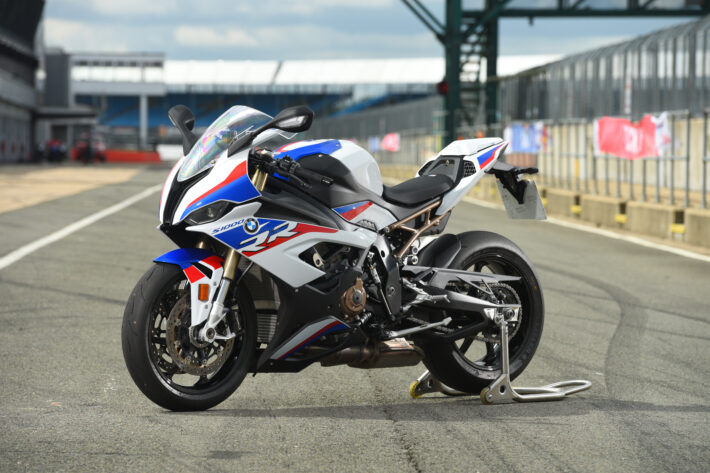
SPECS
Price: £15,290 (base model), £16,700 (Sport variant) £19,315 (with M-Package)
Engine: DOHC 16v, inline-four, l/c, 999cc
Bore x stroke: 80×49.7mm
Compression ratio: 13.3:1
Max power (claimed) 207bhp@13,500rpm
Max torque (claimed) 96ft lb@10,500rpm
Transmission: six speed gearbox, wet slipper assist clutch, chain drive
Frame: cast aluminium twin-beam (adjustable swingarm pivot on M-Package)
Front suspension: 45mm USD fork, fully adjustable (optional DDC electronic suspension system)
Rear suspension: aluminium underslung swingarm, fully adjustable vertical free-floating monoshock (optional DDC electronic suspension system)
Brakes: twin 320mm discs, four-piston Hayes radial calipers (front), 220mm disc, single-piston caliper (rear), cornering ABS.
Wheels/tyres: cast aluminium (carbon fibre on M-Package)/Bridgestone S21, 120/70 17 front, 190/55 17 rear
Rake/trail: 23.1°/93.9mm
Wheelbase: 1,441mm
Kerb weight : 197kg (standard) 193.5kg (M Package)
Fuel capacity: 16.5 litres
Equipment: IMU-based traction control and cornering ABS, cruise control, four rider modes (seven on M-Package), 6.5” TFT colour dash, optional electronic semi-active DDC suspension, integrated rider modes with suspension, up/down quickshifter, hot grips

